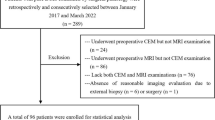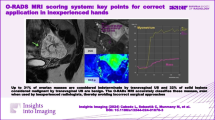Abstract
Purpose
To determine the accuracy of multi-detector CT (MDCT) compared with the surgical findings, such as peritoneal seeding and metastatic lymph nodes, in ovarian cancer patients.
Methods
Fifty-seven FIGO stage IA–IV ovarian cancer patients, who underwent MDCT before primary surgery, were included in this study. Two radiologists evaluated the following imaging findings in consensus: the presence of nodular, plaque-like or infiltrative soft-tissue lesions in peritoneal fat or on the serosal surface; presence of ascites; parietal peritoneal thickening or enhancement; and small bowel wall thickening or distortion. We also evaluated the presence of lymph node metastases. To allow region-specific comparisons, the peritoneal cavity was divided into 13 regions and retroperitoneal lymph nodes were divided into 3 regions. Descriptive statistical data were thus obtained.
Results
The MDCT sensitivity, specificity, positive predictive values, and negative predictive values were 45, 72, 46, and 72%, respectively, for detecting peritoneal seeding and 21, 90, 52, and 69%, respectively, for detecting lymph node metastasis.
Conclusions
MDCT is moderately accurate for detecting peritoneal metastasis and lymph node metastasis in ovarian cancer patients.


Similar content being viewed by others
References
Bristow RE, Puri I, Chi DS (2009) Cytoreductive surgery for recurrent ovarian cancer: a meta-analysis. Gynecol Oncol 112:265–274
Chi DS, Zivanovic O, Palayekar MJ, Eisenhauer EL, Abu-Rustum NR, Sonoda Y et al (2009) A contemporary analysis of the ability of preoperative serum CA-125 to predict primary cytoreductive outcome in patients with advanced ovarian, tubal and peritoneal carcinoma. Gynecol Oncol 112:6–10
Buy JN, Moss AA, Ghossain MA, Sciot C, Malbec L, Vadrot D et al (1988) Peritoneal implants from ovarian tumors: CT findings. Radiology 169:691–694
Coakley FV, Choi PH, Gougoutas CA, Pothuri B, Venkatraman E, Chi D et al (2002) Peritoneal metastases: detection with spiral CT in patients with ovarian cancer. Radiology 223:495–499
Halvorsen RA Jr, Panushka C, Oakley GJ, Letourneau JG, Adcock LL (1991) Intraperitoneal contrast material improves the CT detection of peritoneal metastases. AJR Am J Roentgenol 157:37–40
Jacquet P, Jelinek JS, Steves MA, Sugarbaker PH (1993) Evaluation of computed tomography in patients with peritoneal carcinomatosis. Cancer 72:1631–1636
Tempany CM, Zou KH, Silverman SG, Brown DL, Kurtz AB, McNeil BJ (2000) Staging of advanced ovarian cancer: comparison of imaging modalities—report from the Radiological Diagnostic Oncology Group. Radiology 215:761–767
Walkey MM, Friedman AC, Sohotra P, Radecki PD (1988) CT manifestations of peritoneal carcinomatosis. Am J Roentgenol 150:1035–1041
(1987) Changes in definitions of clinical staging for carcinoma of the cervix and ovary: International Federation of Gynecology and Obstetrics. Am J Obstet Gynecol 156:263–264
Qayyum A, Coakley FV, Westphalen AC, Hricak H, Okuno WT, Powell B (2005) Role of CT and MR imaging in predicting optimal cytoreduction of newly diagnosed primary epithelial ovarian cancer. Gynecol Oncol 96:301–306
Dowdy Samkrbbjhwac Sean C (2004) The utility of computed tomography scans in predicting suboptimal cytoreductive surgery in women with advanced ovarian carcinoma. Cancer 101:346–352
Bristow RE, Duska LR, Lambrou NC, Fishman EK, O’Neill MJ, Trimble EL et al (2000) A model for predicting surgical outcome in patients with advanced ovarian carcinoma using computed tomography. Cancer 89:1532–1540
Lim MC, Bae J, Park SY (2009) In reply: different role of secondary cytoreductive surgery by surgeon’s experience and hospital facility. J Gynecol Oncol 20:199
Lim MC, Lee HS, Jung DC, Choi JY, Seo SS, Park SY (2009) Pathological diagnosis and cytoreduction of cardiophrenic lymph node and pleural metastasis in ovarian cancer patients using video-assisted thoracic surgery. Ann Surg Oncol 16:1990–1996
Song YJ, Lim MC, Kang S, Seo SS, Park JW, Choi HS et al (2009) Total colectomy as part of primary cytoreductive surgery in advanced Mullerian cancer. Gynecol Oncol 114:183–187
Lim MC, Kang S, Lee KS, Han SS, Park SJ, Seo SS et al (2009) The clinical significance of hepatic parenchymal metastasis in patients with primary epithelial ovarian cancer. Gynecol Oncol 112:28–34
Lim SW, Lim SB, Park JY, Park SY, Choi HS, Jeong SY (2008) Outcomes of colorectal anastomoses during pelvic exenteration for gynaecological malignancy. Br J Surg 95:770–773
Lim MC, Lee HS, Kang S, Seo SS, Lee BY, Park SY (2010) Minimizing tumor burden by extensive cytoreductive surgery decreases postoperative venous thromboembolism in ovarian clear cell carcinoma. Arch Gynecol Obstet 281:329–334
Carnino F, Fuda G, Ciccone G, Iskra L, Guercio E, Dadone D et al (1997) Significance of lymph node sampling in epithelial carcinoma of the ovary. Gynecol Oncol 65:467–472
Sakai K, Kamura T, Hirakawa T, Saito T, Kaku T, Nakano H (1997) Relationship between pelvic lymph node involvement and other disease sites in patients with ovarian cancer. Gynecol Oncol 65:164–168
Mironov S, Akin O, Pandit-Taskar N, Hann LE (2007) Ovarian cancer. Radiol Clin North Am 45:149–166
Franiel T, Diederichs G, Engelken F, Elgeti T, Rost J, Rogalla P (2009) Multi-detector CT in peritoneal carcinomatosis: diagnostic role of thin slices and multiplanar reconstructions. Abdom Imaging 34:49–54
Acknowledgments
The authors would like to thank all of the anesthesiologists, surgeons, and surgery nurses at the Center for Uterine Cancer for their invaluable help, patience, and active participation in this study. The authors also would like to thank Wha-Eun Lee and Soo Yeon Jung, research nurses at the National Cancer Center, Korea, for their efforts in gathering and organizing the data and Myungeun Lim (Jessica Lim) for drawing the illustration (Fig. 1). This work was supported by Grants (1010111-1) offered by the National Cancer Center.
Conflict of interest statement
The authors have no conflict of interest to declare.
Author information
Authors and Affiliations
Corresponding author
Additional information
H. J. Choi and M. C. Lim contributed equally to this work.
Rights and permissions
About this article
Cite this article
Choi, H.J., Lim, M.C., Bae, J. et al. Region-based diagnostic performance of multidetector CT for detecting peritoneal seeding in ovarian cancer patients. Arch Gynecol Obstet 283, 353–360 (2011). https://doi.org/10.1007/s00404-010-1442-0
Received:
Accepted:
Published:
Issue Date:
DOI: https://doi.org/10.1007/s00404-010-1442-0




